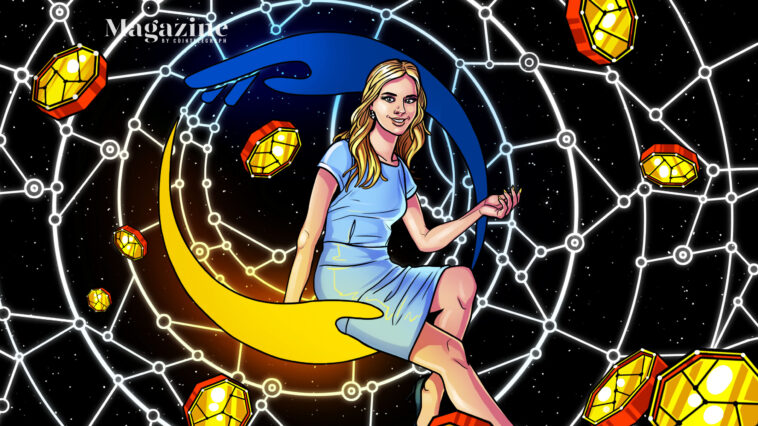Laura K. Inamedinova is a marketing agency CEO from Lithuania who started early with ICOs, a journey that has led her to launch UkrainianPool, an initial staking pool offering raising money for the Ukrainian government.
Inamedinova got into ICOs right out of university in 2016 and is shy to mention the name of the first crypto fundraising project she worked for. There were definitely not only bad projects, but you didnt know at that time, she explains, referring to the early days of the industry. You didnt know that anything was off at the time, she says with a chuckle.
Inamedinovas early plunge into the industry may not have met with success, but after a number of more successful projects such as Waves and CoinGate, her experience has led to a most interesting development: a humanitarian fundraiser in collaboration with the Ukrainian government.
UkrainianPool is a Cardano staking pool that works by allowing anyone to deposit Cardano into the pool, which grows at 5% per year, according to Cardanos staking rewards schedule. Inamedinova explains that this form of charitable support is effectively risk-free because staked tokens can be un-staked at any time and never leave the owners wallet. Inamedinova explains:
Every five days, accumulated rewards get passed on to the Ukrainian governments wallet.
The project became possible after Inamedinova, who was close to a DeFi project that incorporated the ISPO strategy, came to the realization that the staking pools could be used for charity. She shared the idea with Nadiia Dvoinos, a serial entrepreneur who used to run Quadrate 28 an in-house marketing firm for startups. Inamedinova met her on her first visit to Dubai and describes Dvoinos as a mentor.
Dvoinos got in touch with her former business partner Valeriya Ionan, who now serves as Ukraines deputy minister for eurointegration at the Ministry of Digital Transformation. A zoom call was arranged with various government figures on March 8, and UkrainianPool went live soon after.
Only 10 days after the call, Ukrainian Deputy Minister of Digital Transformation Alex Bornyakov explained the project to The New York Times:
Participants do not need to directly donate assets to raise money. Instead, they stake their funds temporarily, which generates high-interest yields that are transferred to a wallet owned by our ministry.
He added that the pools goal is to raise $10 million for humanitarian efforts things such as food, medicine and protective equipment, including helmets and ballistic vests, according to other publications by the ministry.
As far as I know, this is the first charitable project using the ISPO model, Inamedinova notes, referring to an initial staking pool offering.
LKI Consulting
Inamedinova runs LKI Consulting, which has a team of 10 staff members distributed across Europe. We have two Ukrainians; we just hired a refugee, she notes.
The company represents Inamedinovas return to the blockchain marketing niche. As we meet in Dubais Marina Mall in an office overlooking a yacht club, she recounts a meeting she just left. I had to sit through the whole hour to be polite, though I knew within five minutes that it wasnt going to work these guys dont even know what they are building, she laments regarding her prospective clients.
The industry sucked me in without me even planning that, Inamedinova recounts regarding her return to the blockchain industry in 2020 after having previously left behind the glamorous life of an initial coin offering consultant in the 20162017 bull market.
The best of blockchain, every Tuesday
Subscribe for thoughtful explorations and leisurely reads from Magazine.
By subscribing you agree to our Terms of Service and Privacy Policy
This time, the cryptocurrency market was different, as the ICO funding mechanism had gone out of style in part owing to the fact that the majority of ICO investors had lost money during the 2017 cryptocurrency bubble, during which anonymous teams were raising tens of millions of dollars with just a white paper or vague slideshow.
The initial stake pool offering was thought up as an alternative by DeFi project Meld, which conducted one to successfully raise millions in October 2021 after 40,000 users staked over $1 billion of Cardanos ADA. While discussing Melds success with a close friend in the early days of the Russian invasion of Ukraine, they came to a realization that ISPO and Ukraine these two words just made sense, Inamedinova recounts. In addition to Inamedinova, the initiative includes Paulius Vaitkeviius, Ugnius ekas and Karolis Gogaitis, all of whom are from Lithuania.
ICO promoter
Though Inamedinova was born in Lithuanias capital, Vilnius, she spent much of her childhood abroad, first in Vietnam and later in Thailand, where her father worked in the real estate industry. The family moved back to Lithuania as Inamedinova reached her teens, and at 14, she was excited to get a job with a home appliance business owned by a family friend.
My first job wasnt glamorous. It was literally cleaning used washing machines and refrigerators, she recalls, adding that the 15 Litas she made per machine was a significant amount for someone her age in pre-euro Lithuania.
Upon graduating high school, she began a Bachelor of Physics on a full scholarship at Vilnius University in 2012. Despite her love of science, Inamedinova soon decided, Im not going to be a scientist; I dont want to be in the lab for extended periods of time, as Im more of a people person. As she excelled in giving group presentations, Inamedinova felt that my role could be to communicate difficult concepts in a way that is easy to understand and began pursuing internships outside the lab.
Her first internship was in cybersecurity with Barclays bank. The experience broadened her horizons, fuelling a deeper interest in economics and finance. Describing herself as always having held a libertarian outlook, Inamedinova joined a free-market think tank, which she saw as a way to break into the field of economics. After some time in what she describes as a male-dominated industry, Inamedinova says that it was quite clearly communicated between the lines that Im never going to be taken seriously in that sector due to my gender, so she changed course toward the technology industry.
She began helping a friend with a startup that resembled a Kickstarter for startups, where the best ideas get funded, but the project failed to take off.
She also interned at Vinted, a company selling used clothing that went on to become the first unicorn tech company in Lithuania. They were still a small company at the time; I was doing customer support, she recalls.
Though she had no real experience in public relations, she was hired as a communications for Plag, a social media app, whose hiring manager told her, You talk a lot, so I think youll be good with journalists. While taking care of marketing for her employer, Inamedinova came to realize that she also wanted to build a personal brand as an expert in the business and technology sector.
While attending Web Summit in Ireland, Inamedinova met Forbes managing editor Bruce Upbin, who mentioned that the magazine was looking for someone to cover technology in the Baltics, which is where Lithuania is located. I think he liked that I was hustling and building something, and he offered her the opportunity. Beginning in April 2016, she wrote pieces such as 20 Growth-Hacking Strategists You Should Follow In 2016 and, in July, began contributing what she calls thought leader articles to Huffington Post as well.
Her career as a reporter came to an end, however, when a new managing editor took issue with Inamedinovas work in marketing and told her that she should choose to be either a journalist or a public relations person. I was, like, Sorry, Im going to be a PR person, she recalls telling her manager.
It was around this time that crypto came knocking at my door in 2016 when, due to her experience in public relations, a friend of a friend asked for assistance in launching an initial coin offering, or ICO. Though Inamedinova knew little about the blockchain industry, she felt she had nothing to lose.
Laura, why dont you help us fundraise money for our project? Were only gonna have three Ws: Website, White paper, and a Wallet. Were going to be rich. That was his pitch.
The team managed to raise a few million dollars, and Inamedinova realized that she had a unique opportunity at hand. When you do one ICO and talk about it, others start approaching you. This was a huge opportunity for me, as I was only 21 at the time, she recounts. With a year in the industry, she knew she could build a personal brand. I can actually make a difference here. I can be listened to and build something, she reasons, with the existing technology marketing world being far more competitive for a newcomer.
The ICO consulting industry gave Inamedinova the opportunity to travel the world, attending conferences and often giving speeches. Companies she worked with in this time included CoinGate and Waves, both of which were proper and are still operational, she notes.
I was speaking about crypto everywhere in London, Belgrade and a workshop in New York. So, basically, after a year and a half doing crypto, I was the OG, honestly, she says with a laugh.
The clients I worked with in 20162017 raised more than $200 million via crypto funding methods ICOs, STOs, everything like that.
Despite loving the spotlight, Inamedinova took a break for a year as the ICO market dried up. After some reflection, she decided that my career, my business is the most important thing for me and, in 2019, returned to PR work her bread and butter taking the lead of communications at both Cybernews, a technology media outlet, and Aurora Cannabis hemp division. I was always doing at least two things at a time, she explains, adding that she ultimately developed a dislike for the cannabis industry and its promotion of recreational use.
As signs of optimism returned to the crypto market around 2020, so did the need for crypto PR.
I started to get a lot of inquiries from my old acquaintances they needed everything related to crypto marketing.
The future of ISPOs
Considering Cardanos 5% annualized payout, the $10-million goal would require $200 million of ADA to be staked for one year a little less than 1% of the $23.4 billion of ADA, which is currently staked. So far, however, only about $200,000 is staked in the pool, meaning that the biweekly payout to the ministry would amount to a measly $400 funding is 0.1% complete, in other words.
This lack of engagement is somewhat surprising, considering that the vast majority of Cardano staking pools operate in countries considered supportive of Ukraines cause, which would suggest that the Cardano community might also be generally supportive. That said, the drawback of ISPO strategies as they exist so far is that they are limited to single cryptocurrencies, meaning that promotion must target a highly specific community as opposed to cryptocurrency holders in general.
ISPOs can be conducted using any token that offers API for staking, possibly including Ethereum later on.
Inamedinova believes that the ISPO model has a bright future both in charity donations and startup funding because the psychology of contributing money from staking is different from that of more traditional philanthropy or investing, which typically involves budgeting and allocating money away from other competing purposes. Since the whole idea of the staking pool offering is that you dont actually have to give away money, participating in an ISPO does not feel like money is actually being spent.
When people invest, they think there needs to be a certain percentage likelihood of it actually working I could see ISPOs becoming a fun way of funding moonshots.





